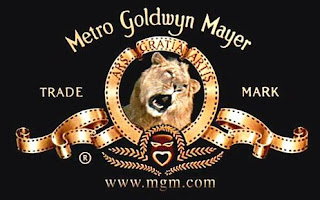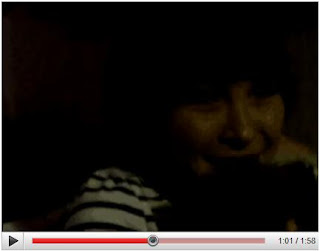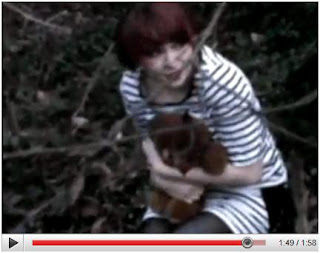1. In what ways does your media product use, develop or challenge forms of real media products?
When planning mine and my groups’ thriller opening, we firstly had to evaluate real thriller openings to identify common conventions used, so we could therefore use them in our own opening.I evaluated different thriller openings with the rest of my group in which we found that all the titles were used at the very beginning of the opening so that the music was completely focused on by the audience; this would therefore create the intended atmosphere and let the audience know what kind of thriller they are watching. (0.00 -0.33) All titles and build up of music with main character singing in the background, this was a main influence from evaluating thriller openings that was used in our own opening. This challenges the normal conventions of a psychotic genre, as shown in ‘Signs’, a lot of distant shots of the main character is used and no talking takes place (2.08 – 3.27 of the signs extract below), whilst our opening uses close ups and midshots of our main character talking to her teddy bear. This was so that the audience would be engaged with our main character straight away and with the additional eery music used in the background of both the titles and when she is playing with her teddies and low key lighting shows that the opening is going to be dark and quite sinister. Also, we centralised her in shot to show her importance, although when the male character enters the room, more time is spent on focusing on him in shot as it emphasises his dominance over her character, as stereotypically, men are the stronger gender.
Another common convention used in thriller openings is a long establishing shot to set a calm base to build tension upon. We also used this in our own opening (0.34 – 0.45). Although, instead of a long shot which is normally used, as shown in the ‘Signs’ extract, we developed on this and used a zoom. This I thought worked well, as it is as if the audience is peering into her window, watching her, almost how it is when she is in the woods.
Although, the mise en scene were all our own ideas. Maizie, (main female actress), is dressed in dark red lipstick and a stripy dress that match the colours of a spinning spiral stereotypically used to hypnotise people, this was used because this linked back to the psychological genre and to emphasise her character isn’t normal. This challenged normal conventions used in thriller openings, as normally to start off with, like in the ‘Signs’ extract, they will make it seem that everything is normal, plain costumes and surroundings to add the creepy feeling that anything can happen to even the most normal looking people. Although the costume we had used in our opening, had apparently instead confused people who had watched it, as they were not sure why a little girl would be wearing make up, but the point was that Maizie was not a little girl, she was of teenage age, but because of the abuse as shown in our opening, it had made her still behave like a child.
Maizie Cast’s character - talking to her teddy bears in ‘Disturbance of the Un-woken’.
2. How does your product represent particular social groups?
For our opening, we used the social stereotype of males’ dominance over women, our main character is a girl who is abused by her father, which is typical of thrillers with abuse storylines. Also woman are stereotypically the weaker sex, we have emphasised this in our opening by using low angles on Maizie and high angles on our main male character Tad. Also, Tad when entering the room is the main focus when it pans over to him walking over to Maizie (0.55 – 0.59), in the shots he is in, he is centralised the whole time and when we edited it, we made it so that he stays for longer in shot than Maizie does. On the other hand, Tad was dressed up purposely with dark rings around his eyes, white t-shirt and jeans, with a drunken bottle of alcohol in his hands, even though we have used the typical woman inferior to men, we made it so that the male was put in a negative light, that the male being in power and control over this girl was a bad thing, emphasised by Maizie’s reaction to the verbal abuse. The audience will connect with Maizie’s character and so sympathy towards her will be created and therefore our opening will appeal to anyone.
I do not think our opening represents any kind of social group, I think we have cleverly made it so that it will appeal to anyone who likes psychological thrillers, the added abuse storyline along with the feeling of being followed creates a more in depth story as it seems it doesn’t matter if she runs away from it, it will always follow her.
3. What kinds of media institution might distribute your media product and why?
The genre of mine and my groups opening is psychological thriller, which means that I had to look at industries who distributed psychological thrillers like ‘The Sixth Sense’, ‘Signs’ and ‘Basic Instinct’. I found that MGM studios have distributed a large amount of thrillers in which most of them are psychological thrillers, for example ‘Basic Instinct 2’, ‘Child in the Night’ and ‘Deceiver’. Therefore, I would think MGM studios would be most interested in our media product as a lot of these psychological thriller films they distribute include focusing on a main characters story, our female character is the main focus of the story, how she deals with the abuse, her running out the house and then wandering around the woods alone (1.34 -1.44) with the feeling of being watched, when all of this goes on, the audience follows and feels the same way that she does, therefore creating the connection between the character and the audience. Camera angles I believe were best to present her being followed were the low angle zoom shot onto her scared, and the handi cam shot of her being crept up on from behind, this is used right at the end of our piece, and I believe this makes a good ending.
Also used in a lot of psychological thrillers they distribute there is a build up of suspense in the story. In our opening the build up of suspense is used twice, when in the house being shouted at by her father (0.53 -1.15) and then again when she feels like she’s being followed in the woods (1.33 – 1.58), the editing at this point is cut more quickly to create the build up of suspense and ties in with more fast paced music than is used at the beginning. I think having the end shot being a climax of suspense is good to keep the audience fixated. MGM studios also released ‘Rebecca’ and ‘Sabotage’ which are both films directed by Alfred Hitchcock, well known for his psychological thriller ‘Psycho’, this proves further that MGM would be best to distribute ‘Disturbance of the Un-woken’ as psychological thrillers obviously appeal a lot to this industry.

4. What would be the audience for your media product?
For our opening we had to justify after researching the BBFC what certificate our opening ‘Disturbance of the Un-woken’ would come under. I thought that my groups opening was a certificate 15 as our opening represented a girl that had been abused, but didn’t show her being abused. Also, no language was used, drugs, nudity or sex. This also ties in with my predicted target audience, as having it as a 15 will allow the younger males I think that our opening would appeal to, to be able see it.
I think the audience for my opening ‘Disturbance of the Un-woken’ would be aimed at young teenage males to males in early twenties. This is because stereotypically the thriller genre appeals more to males, also with our main character being around the same age, this could appeal to our audience further. Furthermore males are stereotypically more simple than females, watching our main character being verbally abused, especially as she is a girl and the story is following her, could be off putting for a female to watch as they will relate emotionally to her character, whilst males may not think about it and instead of being off put by the abuse shown, could be more engaged, because any kind of action or violence stereotypically interests males whilst making the animatic as written in ‘presentation of animatic’ on my blog, we realised that we had done too many distancing shots away from the main character. We had focused more on her running away, and so this therefore meant she was away from the camera a lot of the time, especially as we had so many setting changes, it went from a house, to an alley, to the woods, to another alley and then to a barn house. So a lot of the shots were long shots with the odd point of view. To create characters that would connect with the audience we had to add more close ups, midshots and reaction shots of our main character so that this connection was there and engaging the audience. I think this worked, especially in the house, as sympathy towards her character was created through using close ups, and reaction shots, like the one pictured below. This is an issue we developed on immensely and in our final piece of ‘Disturbance of the Un-woken’ I believe the aimed connection between our main character and the audience is achieved.

Reaction shot of Maizie being Verbally abused.
5. How did you attract your audience?
I think that our engaging of characters attracts our audience. When Tad is verbally abusing Maizie, he is in darker lighting than Maizie is in to show he is a more sinister character, Maizie is in more high key lighting showing that she is innocent, that she does not deserve what is happening to her. Also, the music changes when Tad walks into the room, it is faster paced with lower tones, to emphasise his sinister character and the tension that is built between him and Maizie. Showing that our female character is inferior to this male dominant character will let the audience sympathise with her character and keep them engaged into what happens to her when she runs away from this, as this haunting of being hurt seems to follow her. This then links to the suspense built up by the editing, we used different camera angles in short length so that Maizie wandering through the woods made her look lost and confused, adding to the fact she is not in her right mind. I think this will attract our audience as they will create more sympathy towards her character.
The main prop used was her teddy, which was symbolising the fact that she was clinging onto her childhood. This may have confused the audience, as it seems now that this was not presented in the right way so that people watching would understand that. This is because even though we had a shot of her talking to the teddy, the ongoing confusion of her costume made it difficult for people to know what age she was supposed to be. This was a downfall on our part, but I do not think this affects the aimed connection between Maizie’s character and the audience.
6. What have you learnt about the process of constructing the product?
Constructing our piece was a hard process. The story in which my group and I had originally made is significantly different to how the opening turned out. Originally our female was going to have flashbacks of when she was younger getting abused verbally and chased around the house, scared and frightened. Also, she was going to wake up at the end and so whatever it was that was chasing her in the woods would’ve all been a dream, supposedly. This we were told was too cliché and was also difficult to film because there aren’t many parents who would let their young child be shouted at by a complete stranger. We edited out most of these shots by taking out the pictures from the storyboard, but kept some of the in the house shots that are in the real product, (0.46-0.48). I think editing parts of our original story benefited our piece as we tried to put too much into such little time, which would’ve made the opening too confusing and so benefited our work and audience as it therefore is more engaging as the narrative flowed better.
After making the storyline, storyboard, scripting and filming our shots, we had to edit our footage on an apple mac on premiere pro software. This enabled us to change the lighting, in which we made our shots darker to make the atmosphere more intense. Also it allowed us to add sound, which proved difficult. Finding music that fits in well with the narrative , especially with our piece, as the narrative changes from being in an atmosphere of intensity, when our main female character is being verbally abused, to a build up of suspense, when she’s running away and believing she is being followed. Finding a piece of music to fit both was impossible and so we had to use two different ones that could be merged together and still fit the narrative. This was a slight downfall with my groups final piece, as we focused too much on the narrative and the editing that the sound got pushed aside in priority.
Editing also proved difficult, because I had never used an apple mac before, let alone an editing program, my skills were non-existent, so the equipment I took charge of was the filming equipment. I am now able to assemble a tripod to achieve the shots I want, for example heightening and tilting the tripod to create low angles. Before this I had never used a tripod. I also understand from the filming process why particular shots are used and what they achieve, for example the high and low angles to create the inferior and superior characters. Having the knowledge to use the camera equipment properly is important to produce the best quality shots possible, so the film shoots for me was a good learning process.
7. Looking back to your continuity task, what do you feel that you have learnt in the progression from it to the full product?
I feel that I have learnt a lot from the continuity task project to the final piece. My camera skills improved significantly, making sure that the characters in shot are centralised, emphasising their importance. Also using the camera to tell the story, not the actors, this is what we had tried to do before in our animatic by trying to include a lot of speech into one shot and only changing the camera angles when the characters in the shot moved. This improved in our continuity task as this was the point where we put our high and low angles into practice, making the character who had cheated on the other in our story be looked down upon in mid speech.
Researching into our sub genre made us drastically change our piece, when as a group we analysed thriller openings, we realised that the titles were all shown first in one go, we had separated out our titles onto different shots which proved difficult as our surroundings, for example the shots in the woods, made our text difficult to see. This improved our work, especially as we had difficulties in putting the titles on shots in our chosen colour and font as they couldn’t be seen. Instead we made black background titles that are presented in a slow sequence with eery music to entice in the audience. (0.00- 0.33).
As a group, we struggled with editing, but this has improved since our continuity task. Using transitions became an easy process, we would test each transition to see which one worked best, so we took care into what looked good with our piece. Also, we learnt cutting shots whether shortening them or editing them out became easier, as before when deleting a shot, the effects with that shot, example sounds or transitions, can be deleted with it, which could affect the other shots in the sequence and so now we know to lock the bars that have the affects in them and to cut them down yourself when the shot has been deleted. This made us more confident with the equipment and even though I still have a lot to learn on the editing front, I have still obtained skills that will benefit me in the future, for example knowing how to shorten or lengthen shots in a sequence and adding sound by importing music through itunes on premiere pro and how to add it to a sequence.

Centralising Maizie emphasised her importance in the shots we used.


